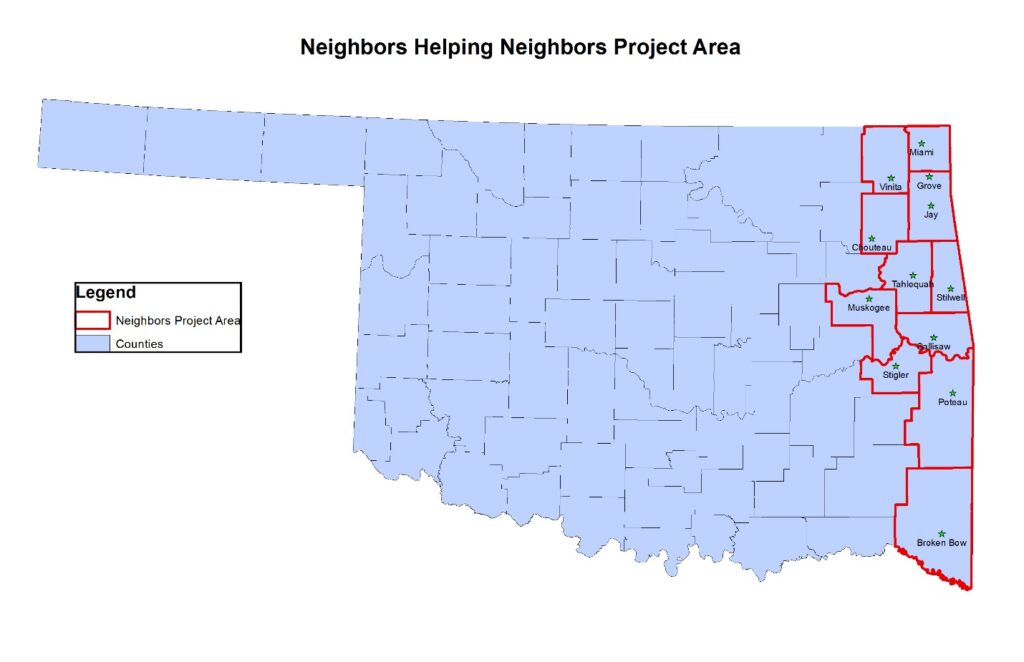About
The Neighbors Helping Neighbors program works with poultry growers and their neighbors to address concerns related to the expansion and evolution of the poultry industry in eastern Oklahoma. Through a unique partnership with multiple organizations, the Oklahoma Conservation Commission has received a Regional Conservation Partnership Program grant to provide education and funding to implement best management practices to address the concerns related to the poultry industry.
Project Area:
The project area includes 11 counties in eastern Oklahoma: Craig; Ottawa; Mayes; Delaware; Cherokee; Wagoner; Adair; Sequoyah; Haskell; Le Flore and McCurtain. These counties were selected as they contain the largest number of poultry farms in the state.


Partners

Purpose
Bringing neighbors and poultry growers together to identify problems and implement solutions that reduce impacts of facilities on the local community by:
- Improving understanding of issues and concerns
- Improving utilization of available or new programs and technologies to address concerns
- Improving communication among neighbors and other partners
- Improving protection of natural resources
- Providing criteria to inform growers and integrators in planning future facilities
Program Services
- Implement conservation practices
- Provide education and outreach to growers and their neighbors
- Implement best management practices on either grower’s or neighbor’s property
- Work with county commissioners on road issues where necessary
- Allow for new, innovative technologies to address issues and concerns
- Find ways to use current technologies or practices in new ways
The Poultry Industry in Oklahoma
The poultry industry in Oklahoma provides over 29,000 jobs with over $1 billion in wages resulting in an economic impact of almost $8 billion. For more information about the poultry industry visit https://ag.ok.gov/divisions/agricultural-environmental-management/.
Water Resources in Oklahoma
All of Oklahoma’s scenic rivers are in the Neighbors Helping Neighbors project area. Water resource-related tourism brings billions of dollars to eastern Oklahoma. Many of the streams in eastern Oklahoma have nutrient related water quality impairments.

Available Programs and Practices
The following is a list of some of the practices available; however, this is not a complete list and the program is open to trying new, innovative ways to address concerns.
Conservation Easements: 30-year livestock or farming exclusions and riparian protection agreements. Practices reduce pollution runoff to streams and helps stabilize streambanks to reduce erosion that may result from increased surface runoff from poultry complexes.
Water Catchment: Provide supplemental water supplies for poultry operations to reduce impacts to rural water delivery issues or groundwater supply concerns. Additional benefit is reduced runoff from facilities.
Filter Strips/Field Borders/Shelterbelts/Windbreaks: These can be installed to help capture runoff of surface pollutants before they leave the farm. They can also help reduce the amount of dust and odor that might impact neighboring landowners. Another benefit is limiting light and noise issues from poultry trucks. The strips, belts and borders could be designed and planted as pollinator habitat. This will not only provide important habitat, but also be aesthetically pleasing.
Ditch-inserted Phosphorus Removal Structures: These structures allow runoff water to pass through a reusable media that captures phosphorus and other pollutants.
Poultry House Exhaust Fan Ammonia Scrubber or Air Washer: These structures “wash” ammonia and dust particles out of poultry house exhaust fans, reducing ammonia loss to the air and ultimately, nitrogen deposition in the rain-shed.
Litter Transfer Program: Transfer litter out of areas with high concentrations of poultry facilities to areas that need additional nitrogen and phosphorous fertilizer.
Litter Storage Facilities: Improvements to litter storage facilities could include providing temporary storage of manure, wastewater or contaminated runoff.
Water/Soil Health Monitoring and Education Programs: Through monitoring, program partners and participants can document changes to water quality and soil health. Healthy soils along with riparian buffers can retain more water on site and protect water quality by reducing runoff into streams. Education on program practices, Q & A sessions with state agency staff and other workshops as determined necessary will be offered.
Animal Mortality Facilities: Updated facilities or installation of new facility to address environmental concerns.
Farmstead Energy Improvements: Developing and implementing farmstead improvements to increase energy efficiency that may include replacing or retrofitting equipment, components or devices.
Building Envelope Improvement: Modify existing structures to regulate heat transfer and reduce energy use.
Locally-Led Cost Share Programs: Implemented through local Conservation Districts. Districts could prioritize practices and applicants to address the most pressing local concerns.
Conservation Planning: Working with Natural Resource Conservation Services staff, we can help facilitate conservation planning for both growers and neighbors on a localized level.
Other Practices and Ideas: Because program funding comes from a variety of sources, new ideas and technologies can be researched and used. Flexibility exists to think outside box.